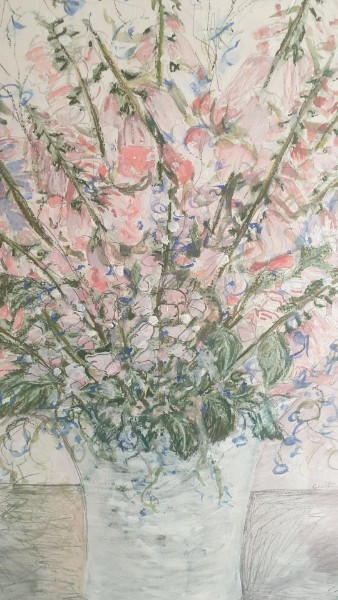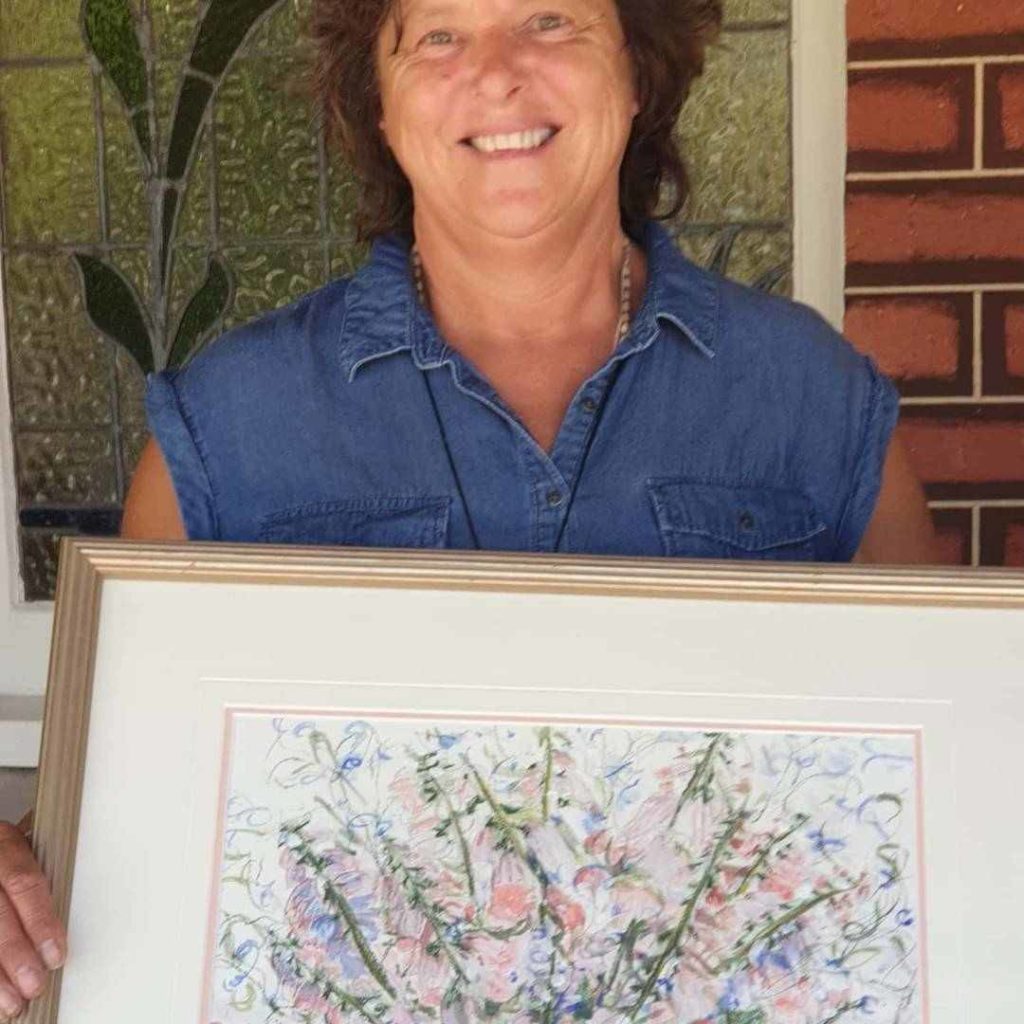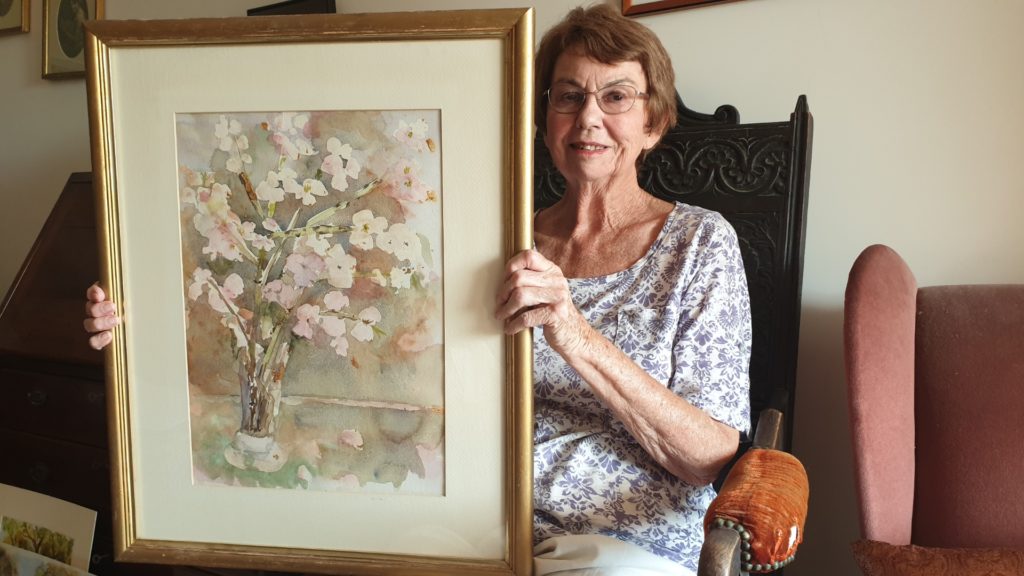"We will remember them"
Poppies are an everlasting symbol of hope, peace and sacrifice. One of the few flowers able to grow after the devastation of war, red poppies are a ritualised remembrance of the blood spilt on the battlefield.
Artwork from The Fairview Art Collection.
Joy Tomcala, Poppies, 1994, watercolour on paper, 30 x 24 com.
Listen to her story in the podcast here.
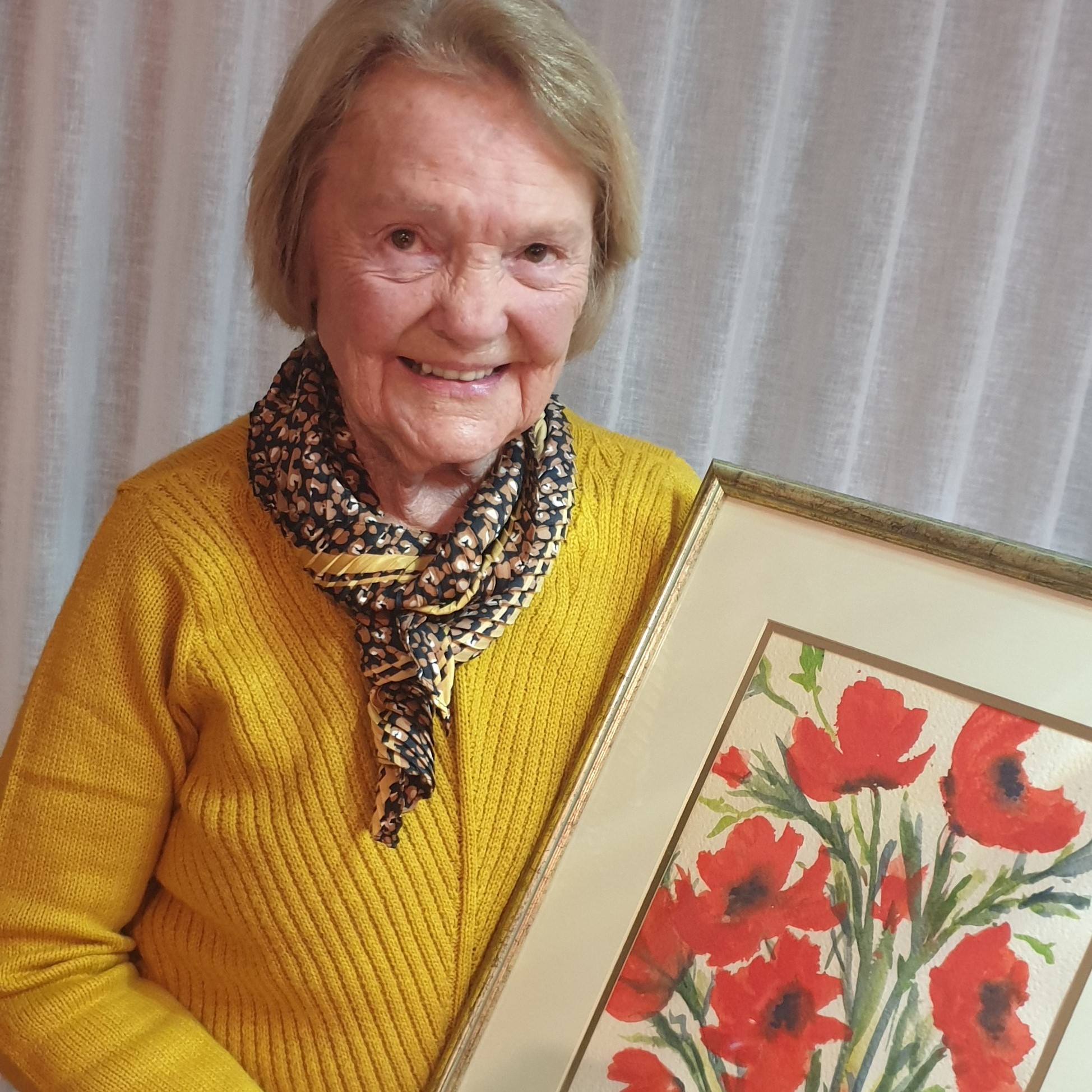
Joy Tomcala (1932) was born in Kalgoorlie, married a Czech refugee, milked 100 shorthorn cows twice a day at Ambergate and at age 54 took up painting, becoming an influential member of the Busselton Art Society Arts Society. She is known for her colourful botanical work, especially poppies inspired by visits to her husband’s European homeland. She was mentored by Faith Hemsley.
Berry, Genevieve (nee McCann)
Genevieve Berry (nee McCann) was born in Sandy Bay in Hobart, Tasmania on the 25th of November 1937 to a musician and music retailer father (Leonard McCann) and homemaker mother (Winnifred Deegan). She married in London to a hydrologist engineer Brendan Berry and between 1963 and 1964 lived in Jordan and Saudi Arabia. They moved to Perth in the early 1970s. Her artistic journey started in 1975 when she studied part-time for a Diploma in Arts Studies at Balga Technical College, Perth. This was followed by a Diploma in Design and Watercolours at St Brigid’s College. Significant art influences have been Sieglinde Battley, Trish Austin and Michelle Everest. She won First Prize in the Trigg Art Club watercolour exhibition award in 1993 and numerous other awards including those presented by the Wanneroo Arts Society. She also exhibited in the “Nine to Five” exhibition held by the Contemporary Art Society of WA at Atwell House in April 1983 and “The Reunion Exhibition – Art of Perth Technical College: A Decade at St Brigid’s Annexe 1978 – 1988”. She has been recognised for her work by the City of Wanneroo and her work is held by the City of Stirling. Genevieve has also taught art and her work is held in many private collections, including a 1991 watercolour “Almond Blossom” in the Fairview Art Collection in Subiaco, Perth.
Davis, Christine Anne (nee Munsel)
Christine Anne Davis (nee Munsel) was born at Merredin in Western Australia’s wheatbelt on 3rd January 1961. She undertook her first studies in Art in Fukuoka, Japan in 1978 as a Rotary Exchange student. She completed a Certificate of Fine Art in 1980 and a Diploma of Fine Art (Painting) in 1982 from the Claremont School of Art and then finished a Bachelor of Education with a major in Textiles and Art History from Curtin University in 1986. She began teaching art at Narrogin Senior High School in 1986, in 1988 began exhibiting at local and regional shows and exhibitions and from 1992 to 1997 was a committee member and then President of the Narrogin Art Gallery. Her first solo exhibition was held there in May of 1999 and forty-five of the fifty pieces for sale were sold. This was followed by Awards by the Royal Agricultural Society and more solo exhibitions at the Narrogin Town Hall in October of 2006, 2007, 2008 and June 2009 before a four-month trip through Europe where she was artist in residence at La Magistere, France. A return exhibition of European Artwork was held in the Narrogin Town Hall for the Annual Spring Festival in October 2009. Between 2002 and 2008 Christine pioneered a new style in the challenging medium of mirrors and artwork. She has been represented in more than 100 invitation exhibitions, including Newman College ArtCenta, South Perth Hospice, St Hilda’s College, Hale School, Arthritis Centre, Millbrook at Williams, Mitchell House at Wagin, Wagin Woolarama, Beverley Art Exhibition and Williams Gateway Exhibition. Her work is held in many private collections, and an especially fine early mixed media work Delphiniums 1988 is held in the Fairview Art Collection in Subiaco, Perth.
Mark D. Phillips
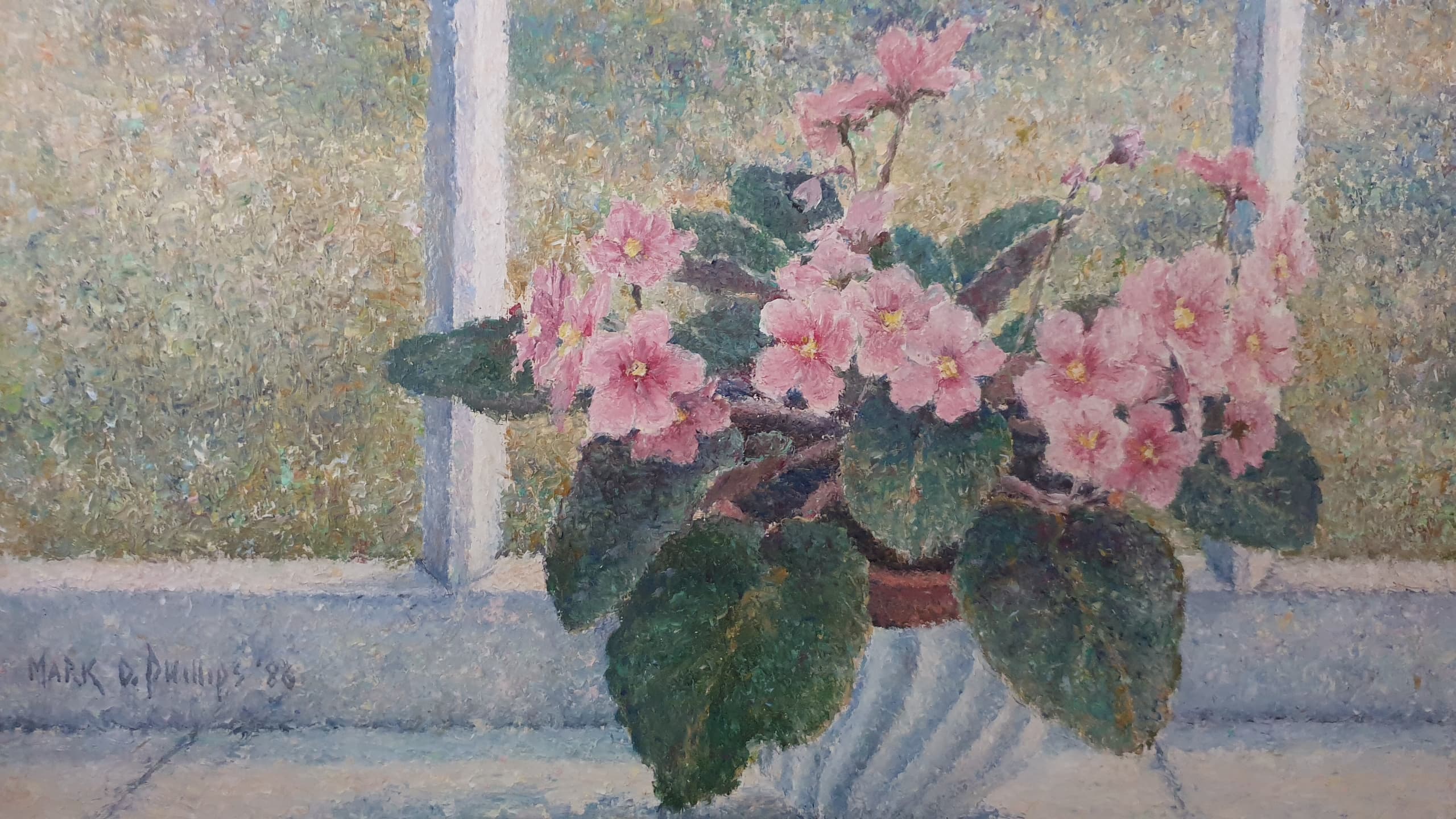
Mark D. Phillips was born in Natal South Africa in 1944 and is a mainly self-taught fine art oil painter and triple winner of the prestigious Australian Society of Artists Annual Exhibition. Based in Durban South Africa, Mark's artworks in oils and acrylics are housed in leading Private Art Collections worldwide. Mark was raised on a farm in the Cape, started painting at the age of ten and initially studied Printing and Typography. He then worked in London and New York ending up in Perth studying at the Gillian Aitken School of Art. Many of his paintings have an impressionistic romantic style. His pastel hues and palette-knife techniques are reminiscent of the 19th century artist Georges Serat who painted with dabs of his brush rather than brush strokes. He has a strong following, especially in Australia, where his popularity reached a peak during his stay in the eighties. He has exhibited in the UK, America, Australia and his home country of South Africa. Mark runs small art classes from his studio in Kloof, South Africa.
Mavis Elizabeth Lightly - West Australian Artist 1920s to 1990s
Mavis Lightly (nee Allen) was born in Collie on 2 December 1911, died on 12 December 1998 and is notable for having been an inaugural foundation member of the Busselton Society of Arts [1].
Mavis was the granddaughter of an engineer from the well-known Irish engineering firm, W.H. Allen. They provided engines from Belfast to mining companies in Queenstown, Tasmania, and Cue, Day Dawn and Collie in Western Australia.
Her father immigrated to Australia as a 16-year-old with his father, who in an ironic twist of fate died from snakebite soon after arrival.
Her father ended up in Collie selling engines and then ran a family garage in Busselton in the 1920s. Mavis was brought up in the family home behind the garage.
In an oral history interview recorded in 1985, Mrs Lightly recalls as a five-year old drawing a compelling picture of a Model-T Ford on the classroom blackboard which remained up for nearly a year.
At age 15 she was privately tutored by an English artist by the name of Baker. She left school then and as the eighth child by eight years she was looked after by other family members and not allowed to work.
This reflected the social and cultural norms at the time and the low expectations of women.
She married at 20, farming in the Vasse region and raising two children, Ian and Lynette.
In the recorded interview she describes her art practice as a pleasure and habit with no pressure to produce commercially sought after works. Like so many other women artists of the time she describes her art as “a casual hobby”.
After the Second World War, Mavis moved from the farm to Busselton becoming a serious painter and a student of Margaret Johnson [2]. She used oil and with two small children had a passion for drawing on paper with charcoal being interested in all subjects - landscape, still life, and portraits.
“Margaret Johnson recognised I had some talent and took an interest in me,” Mavis told her social history interviewer in 1985.
Margaret G. Johnson, (1898 – 1967) was a Sri-Lankan born Australian portrait artist. Her father James Wood, was a Scotsman in Kadugannawa, Ceylon. She was one of seven children who all had an interest painting and drawing. At a young age her father immigrated to Western Australia and after completing her schooling in Perth was sent to the Glasgow School of Art at the tender age of fifteen, three years younger than the usual entrance age.
Margaret studied under Maurice Greiffenhagen and Professor McKeller, concentrating on painting and modelling. She completed her four-year course in three years and returned to Western Australia after the end of World War One and married.
As a portrait artist she specialised in portraiture painting especially watercolours but also had works in pencil, pastels and oil. Her portrait works are found in the National Gallery of Australia, Parliament House and at the Perth City Council. For example, her portrait of Prime Minister John Curtin hangs in the Art Gallery of Western Australia.
In 1934, her model for a portrait plaque of pioneering women’s activist and politician Edith Cowan was chosen from several local West Australian entries to be the choice for a memorial work on a clock tower in Kings Park, Perth honouring the trailblazer. The Edith Cowan bust is in high relief above a wreath of gum leaves and nuts cast in bronze and is visible today on the eastern face of the clock tower.
Ms Johnson was a member of the West Australian Society of Arts and taught Mavis Lightly at the Busselton Technical School.
Mavis had her first Art Exhibition in 1952 in the Country Women’s Association Hall, before the Busselton Arts Society was formed and every item was sold at prices ranging from five to 18 guineas [3].
This was followed by several other exhibitions.
“My early work can more than hold their own, even after art classes by Boissevain and Juniper and you develop your own style and my style has been retained largely due to that early influence of Margaret Johnston where I learnt the basics of distance, composition, colour, coordination and application, have your own colours but have your tonal values right,” she said.
Boissevain and Juniper are considered WA Art Royalty and their influence extends far beyond their extensive body of work because they also had longevity as art teachers.
For example, William 'Wim' Boissevain (born 23 July 1927) was born Willem Geoffrey Boissevain in New York, son of Gideon Walrave 'Gi' Boissevain who was in the Dutch diplomatic service.
With his roots in the Netherlands and international upbringing, he was drawn back to Europe and studied at the Central School of Arts and Crafts, London and the École nationale supérieure des Beaux-Arts, Paris.
Arriving in Australia in 1947 he became naturalised in 1949 and is well-known for his studio at Glen Forrest in the Darling Range near Perth.
Contrasting this Dutch heritage, Robert Litchfield Juniper, AM (7 January 1929 – 20 December 2012) had a broader art practice covering artist, art teacher, illustrator, painter, printmaker and sculptor and was born in the dusty light-filled wheat-belt town of Merredin in Western Australia.
Like Boissevain he was drawn to Europe and studied commercial art and industrial design at Beckenham School of Art in England and in a striking similarity was also a long-term resident in the Perth hills where he was involved with the Darlington Arts Festival.
The strong loyalty and admiration Mavis Lightly felt towards her female teachers and mentors like Johnson rather than men, demonstrates how early Australian women artists supported and nurtured each other.
In the first 'Art in the Park', the longest running exhibition of its kind in Western Australia, held in Mitchell Park Busselton from the 19th to the 24th January 1960, Mavis Lightly had one oil and eight water colour works for sale, with her highest priced, an oil called 'Winter Pattern' selling for eight guineas, the second most expensive piece of art on offer [4].
Mavis Lightly won the $500 Tom Wardle Prize for oils at the 1968 Busselton Art Society Competition, reputed by Society Patron, Sir Claude Hotchin to be the richest art prize offered outside the Perth metropolitan area [5]. Her entry, 'Still Life' 370 x 475 mm is part of The Busselton Art Society collection, the largest private art collection in the South West of Western Australia.
“I also taught art, always all ladies,” Ms Lightly said. This reflects the economic necessity of women artists of the time supplementing the household income from other sources than pure art sales. History repeating itself, much like how Margaret Johnson had taught Mavis Lightly decades before.
White Camellias was purchased at a garage sale run by a charity group in 2017. The work is significant as it reflects the artists unique still life style and her depth of tonal colours.
The framing reflects the frugal nature of the period. A busy time as a farming mother raising toddlers, with a husband often away, and money more likely to be directed to other activities rather than framing.
“If it’s a complicated painting, I always have a simple frame,” she concludes in her oral history interview.
